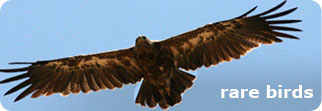 Lesser Kestrel (Falco naumanni), a falcon resembling Kestrel (Falco tinnunculus), the commonest falcon in Greece and Europe, is included in the list of the world threatened species.
Lesser Kestrel (Falco naumanni), a falcon resembling Kestrel (Falco tinnunculus), the commonest falcon in Greece and Europe, is included in the list of the world threatened species.
Inhabitants of some villages of Thessaly, Tripolis, Ioannina and Galaxidi may not believe this. They all agree, however, that its population has declined seriously during the last decades. In addition, it has been exterminated from many other villages, as well as from many European countries.
One of the first birds every birdwatcher is learning to distinguish is Kestrel and taking this as a model he identifies every other falcon. He compares the size, the color, the tail patterns, the size of the eye-ring, the pattern of flight etc.
Lesser Kestrel, however, is very difficult for the novice birdwatcher. Its differences from the similar and very related Kestrel are the following: It is more light colored underneath, the colors above are softer and male’s secondary coverts are bluish grey.
Its flight is more active, while hovering (flying on the spot in search for prey) lasts for 6 seconds at most. Then we can also distinguish its angular tail as well as the larger outer tail feathers.
 In the winter they are very rare to see in our country, except from exceptionally rare occasions. At early spring, when they return from Africa where they wintered, we will see them in large groups on electricity poles or telephone cables, or all together on solitary trees in the plains. After that, they scatter at breeding sites.
In the winter they are very rare to see in our country, except from exceptionally rare occasions. At early spring, when they return from Africa where they wintered, we will see them in large groups on electricity poles or telephone cables, or all together on solitary trees in the plains. After that, they scatter at breeding sites.
The vast majority is concentrated on villages, where they nest in old houses or warehouses. An old warehouse may be the nesting site for many tens of birds.
 Their nest is sketchy, with no concentration of material. They exploit every possible site. In Thessaly we located them nesting along with pigeons. Very few continue to nest in natural environments, like rock holes, cliffs, tree holes and old Hooded Crows’ nests.
Their nest is sketchy, with no concentration of material. They exploit every possible site. In Thessaly we located them nesting along with pigeons. Very few continue to nest in natural environments, like rock holes, cliffs, tree holes and old Hooded Crows’ nests.
At the end of summer, when young birds become independent, they gather in large groups and roost all together at night in tree stands, near or in villages in Thessaly, or in parks as for example in Tripolis or Ioannina. At this time of year, groups of many hundreds can be observed in some locations.
They migrate in a broad front to Africa but we still don’t know the migration corridors and the exact destination place of the populations that breed in Greece. Ringings made by the Hellenic Ornithological Society have not yielded any result yet.
Distribution of the species includes all the open areas of the Palearctic (from Spain to NE China and N Africa) with steppic habitats, cereal cultivations, pastures, phrygana and dry partly forested areas.
Large cereal cultivations resemble steppe, and we could call them pseudosteppes. Lesser Kestrels were excellently adapted to these areas. As in open landscapes in steppes and savannas it hunts locusts and its favorite "delicacy", the onion-eater (Grylotalpidae). It also feeds on mice and lizards. When farmers burn reedbeds, we see them along with Storks hunting mice and locusts trying to escape.
Farmers know this and they protect them. However, countrymen’s connection with land is not what it used to be in the past, and young people are often ignorant of the surrounding nature. Many colonies in our country were wiped out by air guns, just for fun.
 This is not the only threat. A basic problem in our country is the reduction of safe nesting places. Old buildings, built by mud-bricks, and warehouses are being crumbled. Tiles are replaced by plates or new roofs that leave no holes, while no one is thinking of creating eaves for House Martins, Pigeons and Lesser Kestrels.
This is not the only threat. A basic problem in our country is the reduction of safe nesting places. Old buildings, built by mud-bricks, and warehouses are being crumbled. Tiles are replaced by plates or new roofs that leave no holes, while no one is thinking of creating eaves for House Martins, Pigeons and Lesser Kestrels.
Changes in agriculture by the intensification of cultivations, irrigations, insecticide use, the destruction of hedges and fallow areas, have reduced available food for Lesser Kestrel. Pastures and fallows which are the best feeding areas in the plains, are reduced, giving their place to intensively irrigated farmland.
In other areas, overgrazing and vegetation destruction have created a serious problem due to erosion, while hilly and mountainous regions suffer from cattle raising abandonment, which leads to vegetation thickening, disqualifying the habitat for the species. The same problems are being faced by all insectivore species of farmland like swallows, Roller, owls, Hobby etc.
We don’t know yet if insecticide and pesticide use influence breeding, or which are exactly the threats for this species in the wintering sites in Africa. Today, no one can be sure for obvious things such as that swallows and Lesser Kestrels will come back in spring, that they will lay eggs that will be hatched, and that they will raise their chicks normally.
HOS is systematically studying this species, rings and concentrates data for 5 years. Most of the species’ colonies have been recorded in more than 15 nomes. Lesser Kestrels are our flag for the conservation of the rural environment. So, every information for its present or past distribution is vital, and you can communicate with our office in Thessaloniki.


 Lesser Kestrel (Falco naumanni), a falcon resembling Kestrel (Falco tinnunculus), the commonest falcon in Greece and Europe, is included in the list of the world threatened species.
Lesser Kestrel (Falco naumanni), a falcon resembling Kestrel (Falco tinnunculus), the commonest falcon in Greece and Europe, is included in the list of the world threatened species. In the winter they are very rare to see in our country, except from exceptionally rare occasions. At early spring, when they return from Africa where they wintered, we will see them in large groups on electricity poles or telephone cables, or all together on solitary trees in the plains. After that, they scatter at breeding sites.
In the winter they are very rare to see in our country, except from exceptionally rare occasions. At early spring, when they return from Africa where they wintered, we will see them in large groups on electricity poles or telephone cables, or all together on solitary trees in the plains. After that, they scatter at breeding sites. Their nest is sketchy, with no concentration of material. They exploit every possible site. In Thessaly we located them nesting along with pigeons. Very few continue to nest in natural environments, like rock holes, cliffs, tree holes and old Hooded Crows’ nests.
Their nest is sketchy, with no concentration of material. They exploit every possible site. In Thessaly we located them nesting along with pigeons. Very few continue to nest in natural environments, like rock holes, cliffs, tree holes and old Hooded Crows’ nests. This is not the only threat. A basic problem in our country is the reduction of safe nesting places. Old buildings, built by mud-bricks, and warehouses are being crumbled. Tiles are replaced by plates or new roofs that leave no holes, while no one is thinking of creating eaves for House Martins, Pigeons and Lesser Kestrels.
This is not the only threat. A basic problem in our country is the reduction of safe nesting places. Old buildings, built by mud-bricks, and warehouses are being crumbled. Tiles are replaced by plates or new roofs that leave no holes, while no one is thinking of creating eaves for House Martins, Pigeons and Lesser Kestrels.
